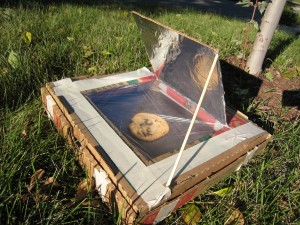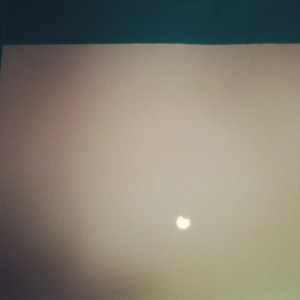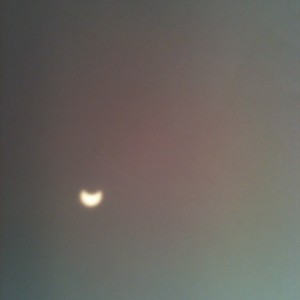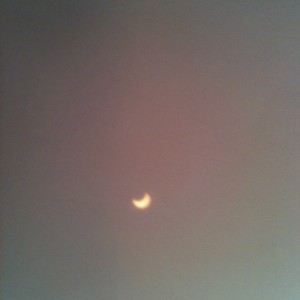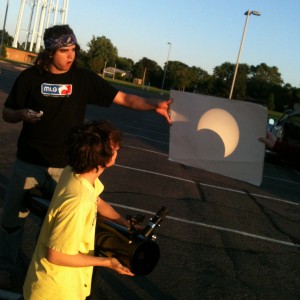Tag: solar’
Shoe Box Solar Viewer for Watching a Solar Eclipse
- by KitchenPantryScientist
Here’s how to make simple solar viewers to indirectly view an eclipse.
NEVER look directly at the sun, since you can permanently damage your retinas (the light sensors on the back of your eyeballs.)
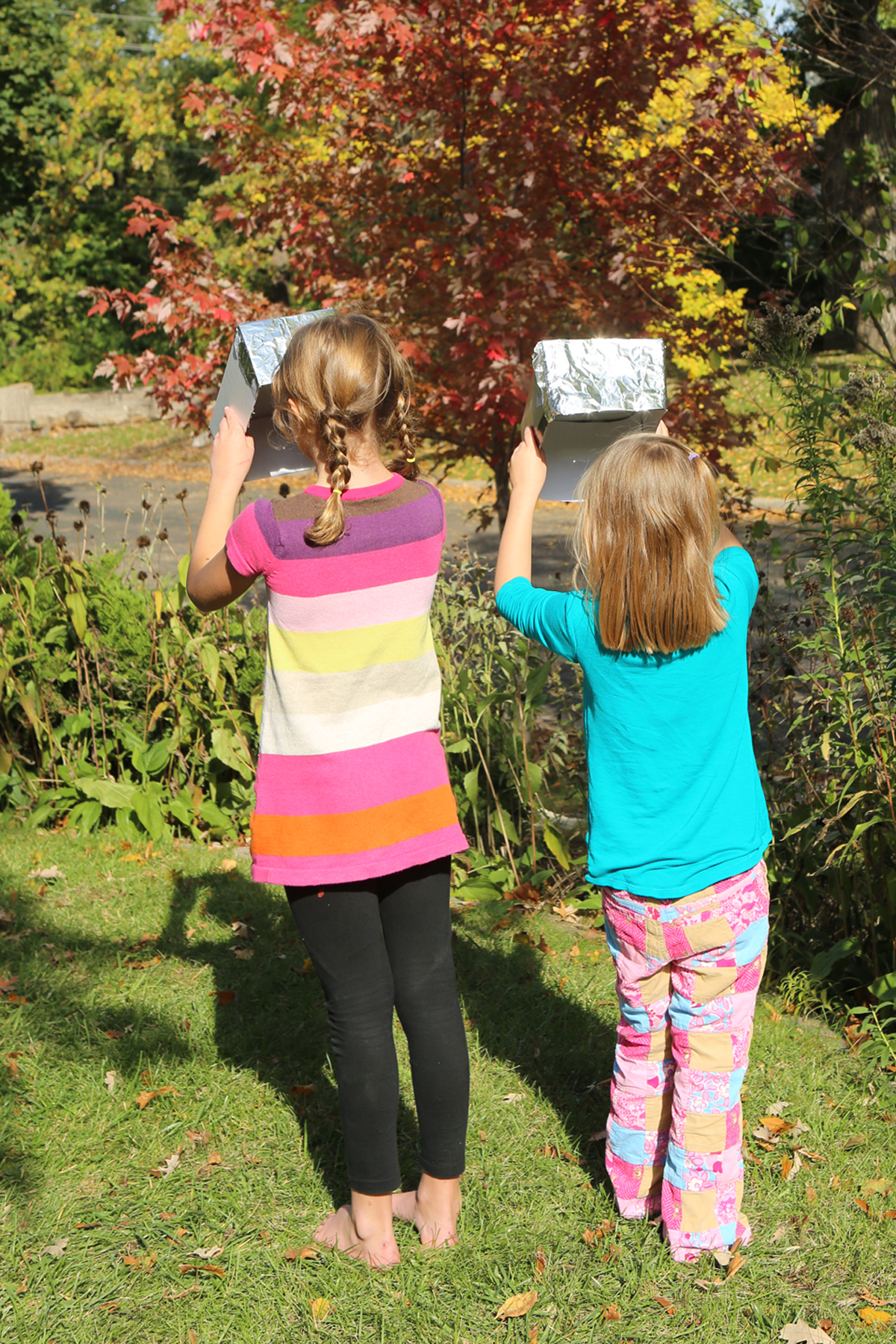
You can safety view the sun (and therefore a solar eclipse) using a shoe box by standing with the sun BEHIND you. All you need is a shoe box without a lid, a piece of white paper, aluminum foil, a pin and tape. It’s perfect for viewing a solar eclipse, like the one coming up this afternoon. It will be visible from around 4:30 CST until 6:00 PM CST here in Minnesota!
A solar eclipse happens when the moon passes between the sun and the earth, blocking the sun from view.Go to this eclipse calculator to see when and where you can best view the eclipse with your viewer! Here in Minnesota, we’ll see a partial eclipse.
First, tape white paper over one end of the shoe box (on the inside.) This is your viewing screen.
Then, cut a big notch out of the other end of the shoe box and tape aluminum foil over it.
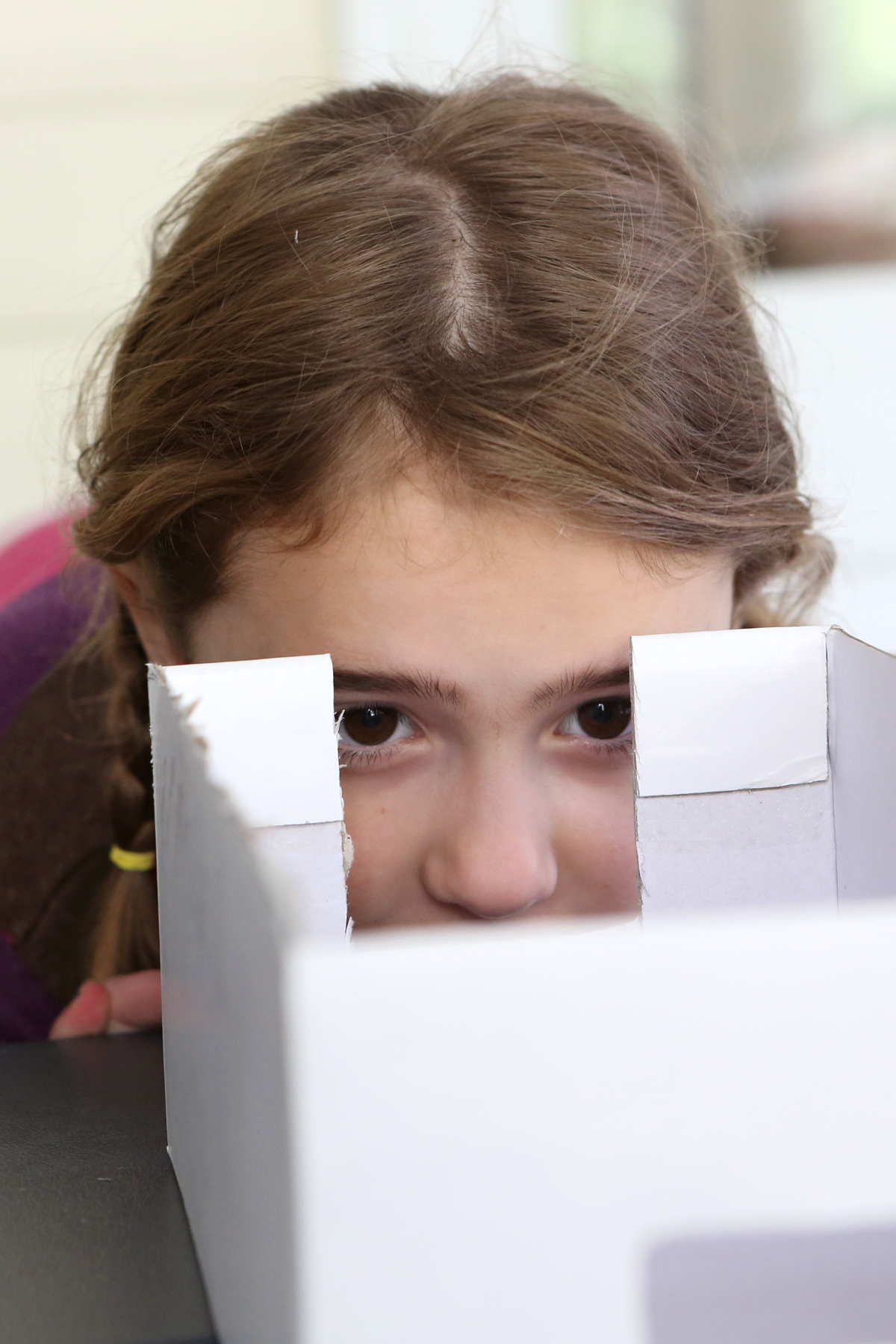
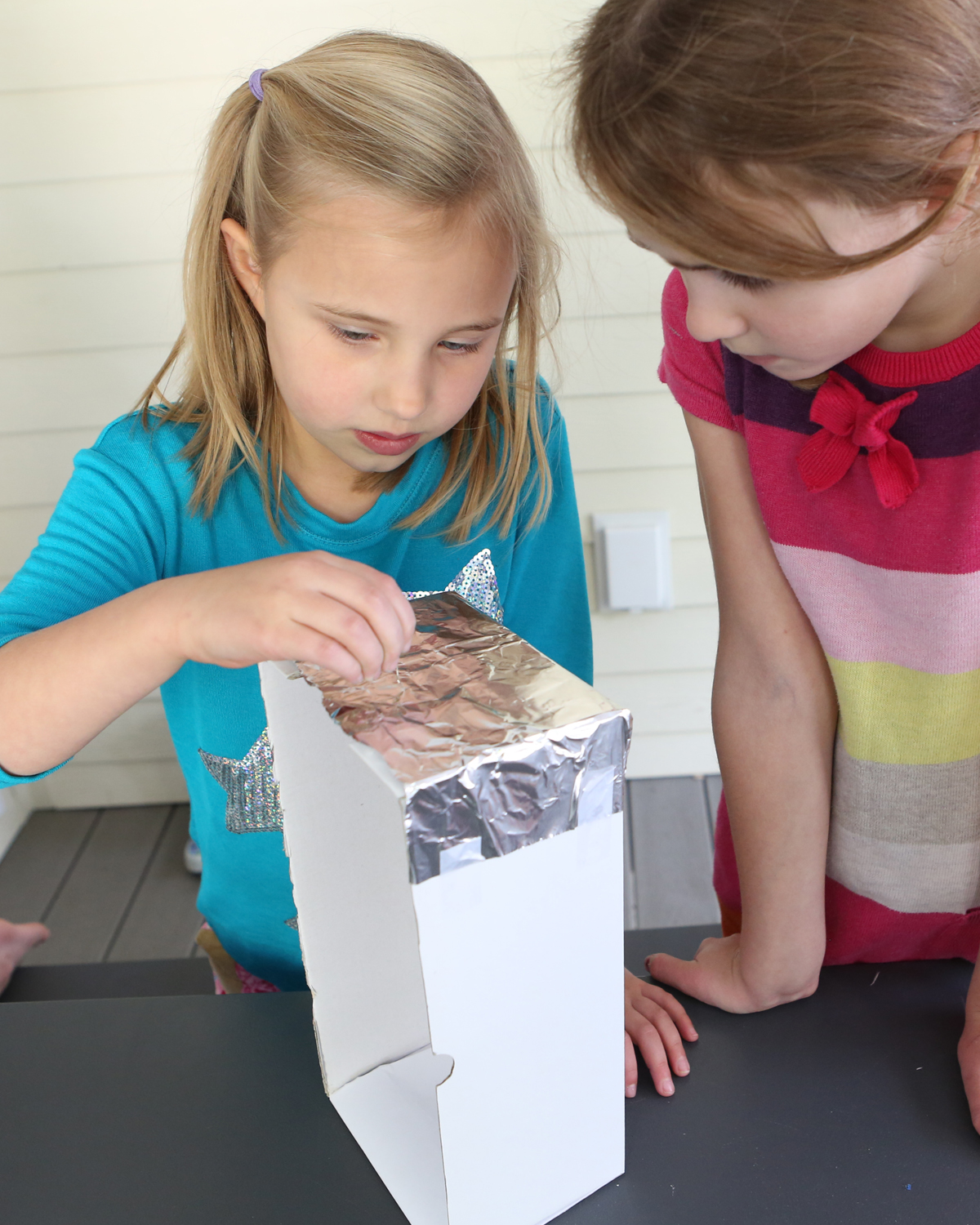
Use a pin to poke a hole in the center of the foil. If you mess up, you can always put new foil on and try again. The smaller the hole, the better the focus, but we made ours a little bigger than the actual size of the pin.
Now, stand with the sun BEHIND you. (See photo at top of post. The sun is behind the girls, high in the sky.) NEVER LOOK AT THE SUN THROUGH THE PINHOLE ITSELF.
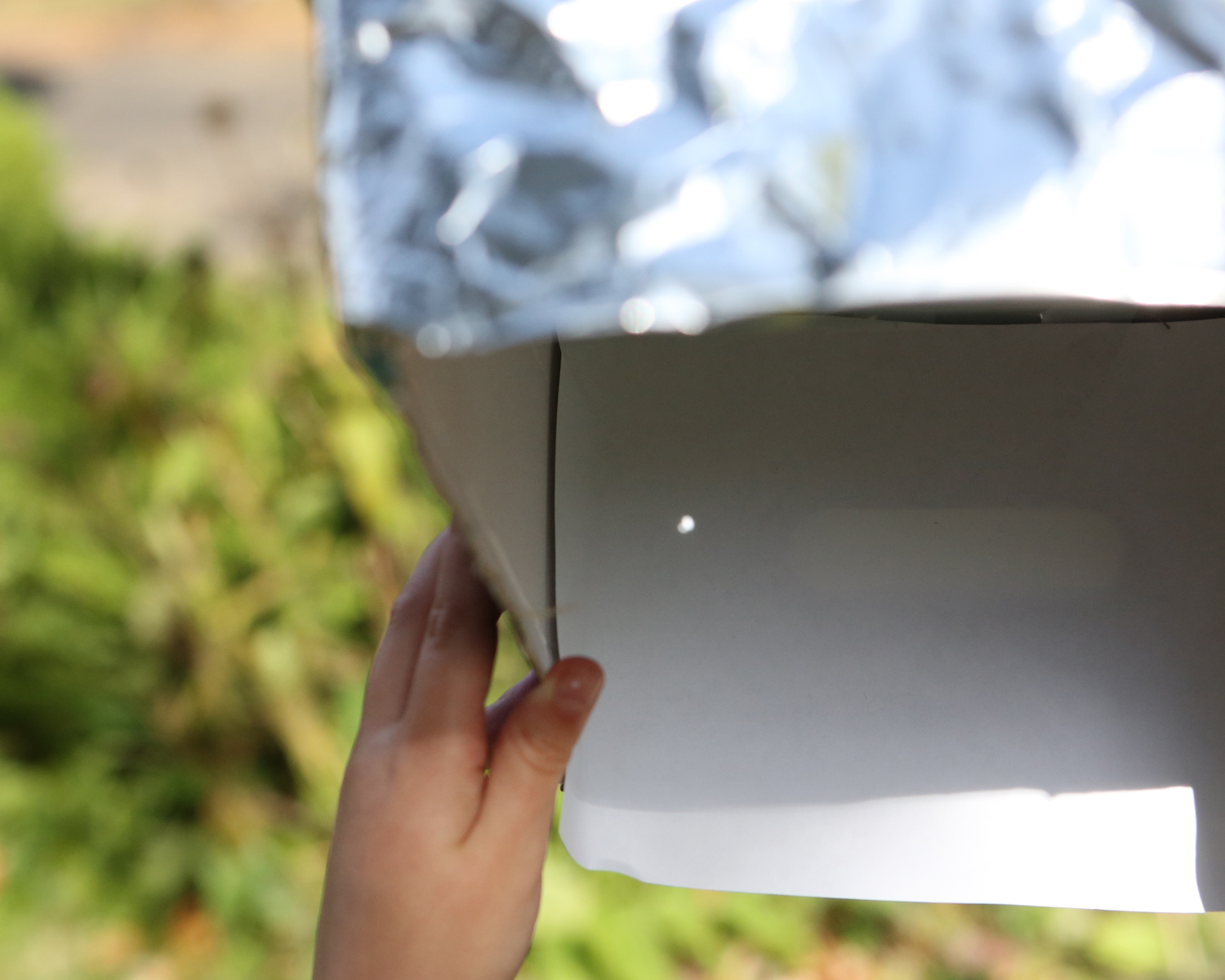
Hold the box upside down so the pinhole is pointed at the sun behind you. The foil should be behind your line of sight so it’s not reflecting the sun in your eyes. Light rays from the sun will shine through the pinhole and project an (upside down) image on the white paper.
Practice on a sunny day (or when the sun peeks out between the clouds) so that you know what to do when it’s time for the eclipse. Small children should be supervised so they don’t try to look directly at the sun.
You can do the same thing using two white index card, poking a hole in one you hold nearest to you and projecting the image on the one you hold away from you (with the sun behind you.)
Or, if you’d rather order “eclipse glasses”, here’s a link for where to buy AAS-approved and tested solar viewers.
If you’re interested in projecting a larger image of the sun, try making a solar viewer from binoculars, a tripod and a white piece of paper. Click here for directions!
Enjoy! Watching an eclipse in the 70s after my dad came to school and helped us all make these boxes is one of my earliest “science” memories!
Kids Summer Science: Pizza Box Solar Oven
- by KitchenPantryScientist

A warm, sunny spring or summer day is perfect for making a solar oven from a pizza box!
When my friend Sheila, who works at NREL (the National Renewable Energy Laboratory) sent me this project, I couldn’t wait to try it out. We first tried it out on a cool spring day in Minnesota and to my surprise, it worked. The oven didn’t get very hot, but we were able to warm a chocolate chip cookie enough to make it soft and melt the chips.
NREL suggests using your oven to make s’mores, which we’ve tried and is really fun. The solar oven is surprisingly easy to make and is one of the experiments featured in my book Kitchen Science Lab for Kids. (Quarry Books 2014)
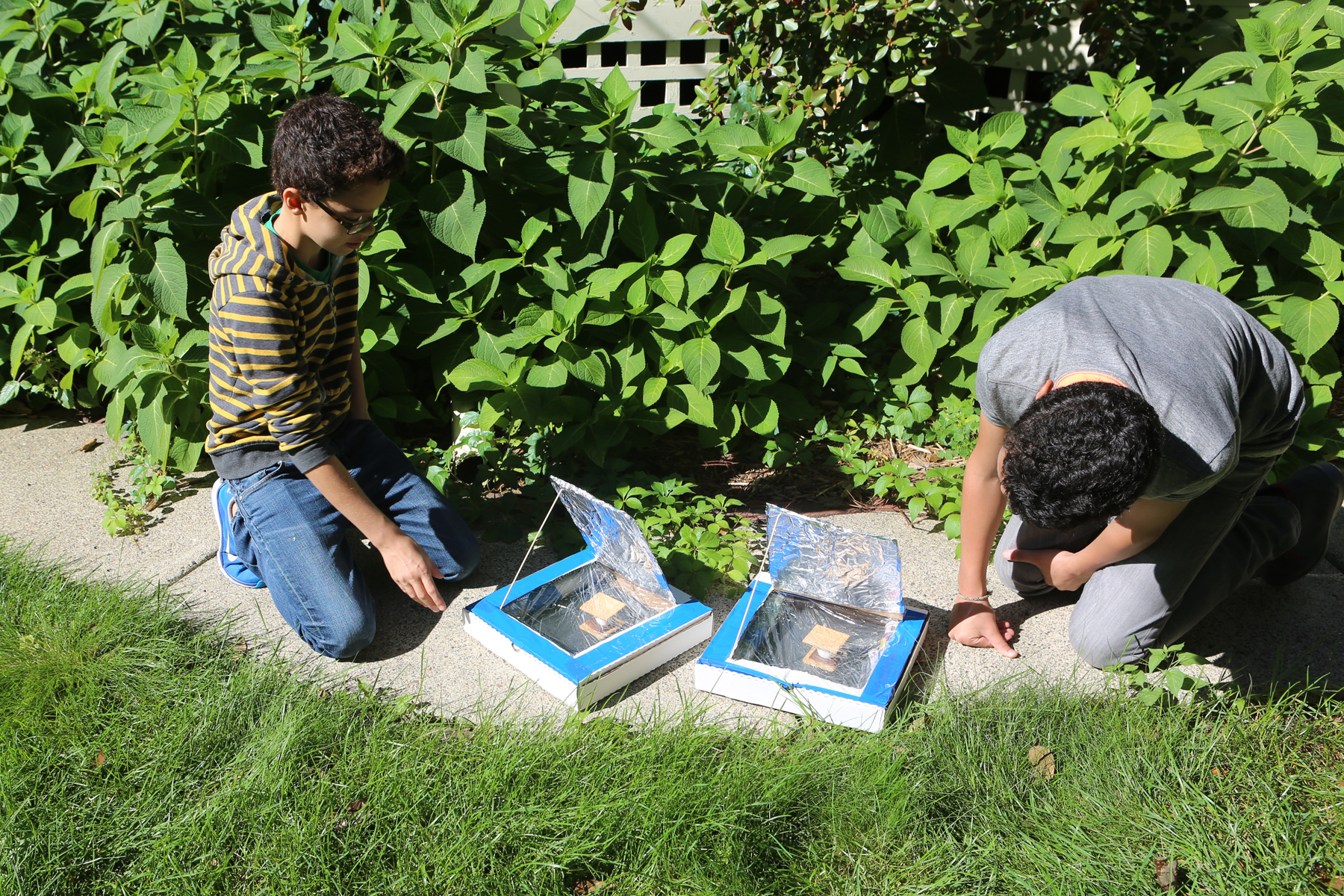
Solar Oven from Kitchen Science Lab for Kids (Quarry Books)
You will need: 1 pizza box from a local pizza delivery store (Little Caesars, Domino’s, Pizza Hut, etc.), newspapers, tape, scissors, black construction paper, clear plastic wrap, aluminum foil and a dowel or stick to prop the lid up. You will also want to have some food to warm in your oven-marshmallows, chocolate, etc.
Make sure the cardboard is folded into its box shape. Carefully cut out 3 sides of a square in the lid of the box. Do not cut out the fourth side of the square, which is the one closest to where the pizza box lid hinges. Gently fold the flap back along the uncut edge to form a crease.
Now, Wrap the underside (inside) face of the flap that you made with aluminum foil. Tape it so that the foil is help firmly but so that there’s not too much tape showing on the foil side of the flap.
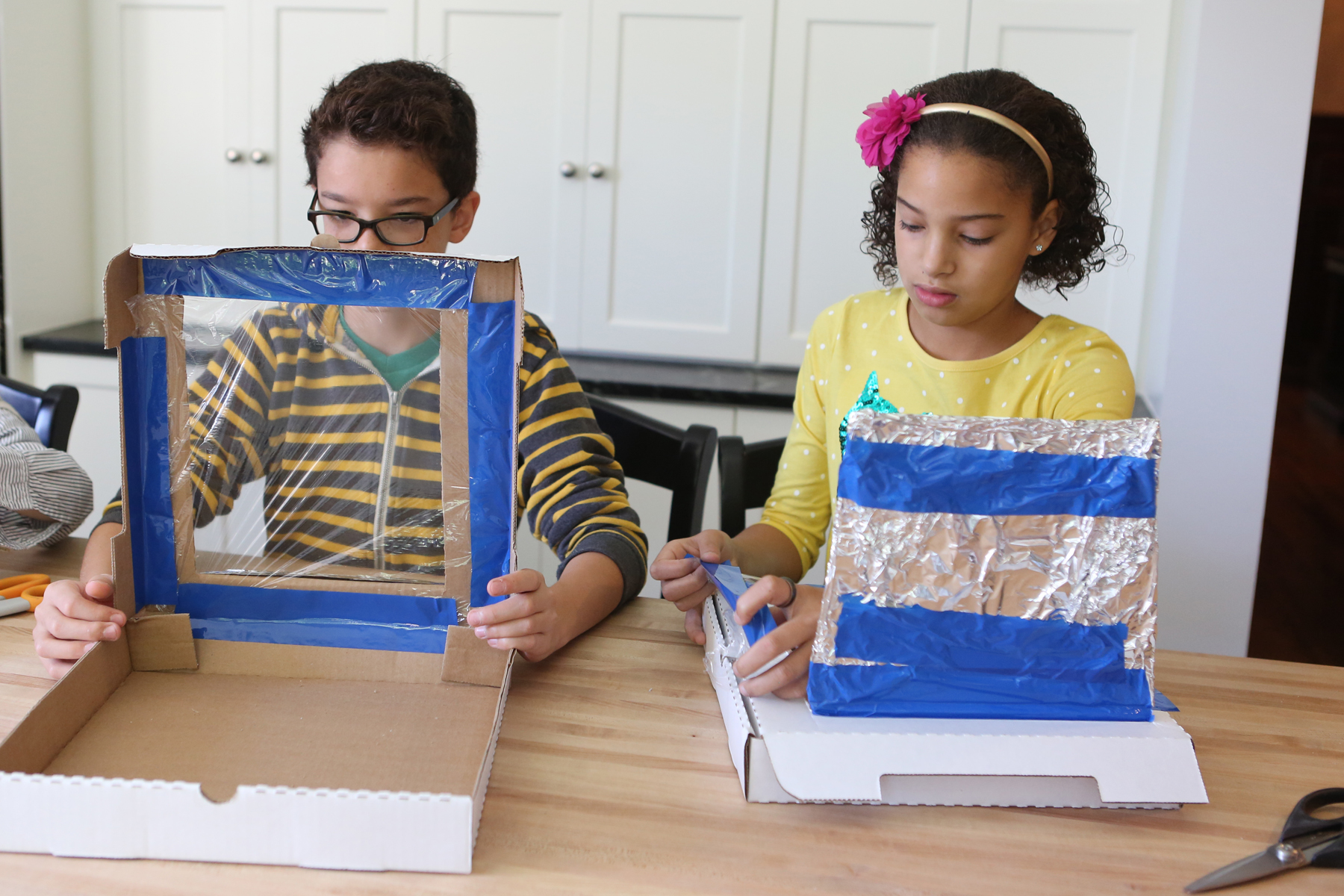
Solar Oven from Kitchen Science Lab for Kids (Quarry Books)
Open the box and place a piece of black construction paper so that it fits the bottom of the box. Tape it by the edges. (We used two pieces.)
Roll up some newspaper and fit it around the inside edges of the box. This is the insulation. It should be about 1-1 ½” thick. Use tape (or other materials you can think of) to hold the newspaper in place. Tape it to the bottom of the box so that you can close the lid. (We taped it to the sides and had to cut the tape so that we could close the lid. Luckily our newspaper fit in tightly enough that we didn’t really even need the tape.)

Finally, cut plastic wrap an inch larger than the lid opening on the box top. Tape it on the underside of the lid opening. Add another piece of plastic wrap to the top of the lid opening. This creates a layer of air as insulation that keeps heat in the box. It also makes a window you can look through at the food you’re “cooking.” BE SURE THE PLASTIC WRAP IS TIGHT.
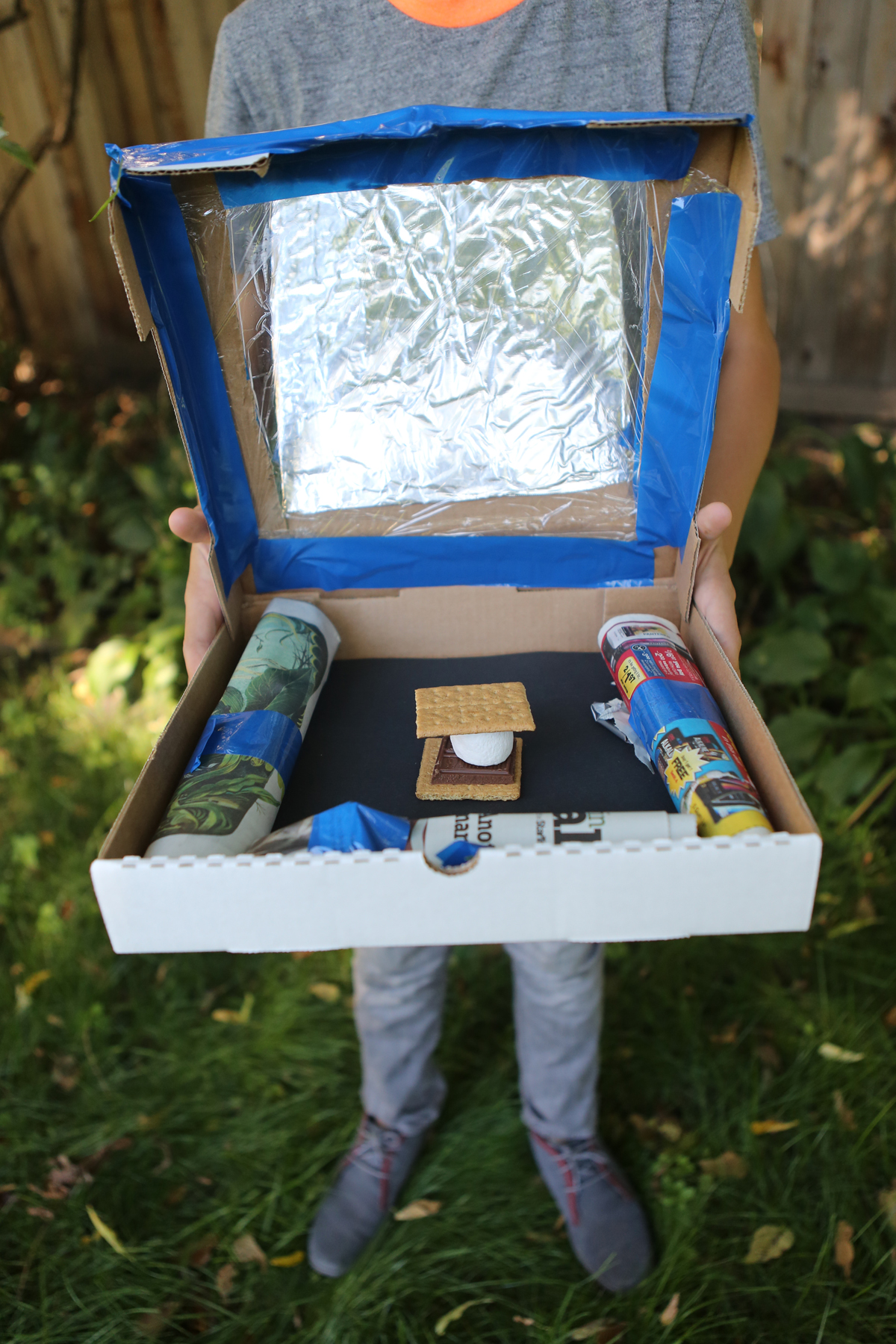
You are almost done! According to NREL, the oven needs to sit at an angle facing the sun directly so you’ll need to make a prop. You could probably just use a book or something under the hinged side of the oven. However, I missed this when I read the directions and we just put it flat on the ground. The flap of the box top needs to be propped open—a dowel or ruler works great. We used a wooden skewer that I broke the sharp point off of. This way you can change the amount of sunlight striking the oven window. Play with the angle of the flap to see how much sunlight you can get to reflect on the food.
Check every once in a while to see how well your food is being heated by solar thermal energy. If you’re is interested in finding out how the sun cooked your food, go to http://www.nrel.gov/ NREL’s website has great information on solar energy and many other sources of renewable energy.
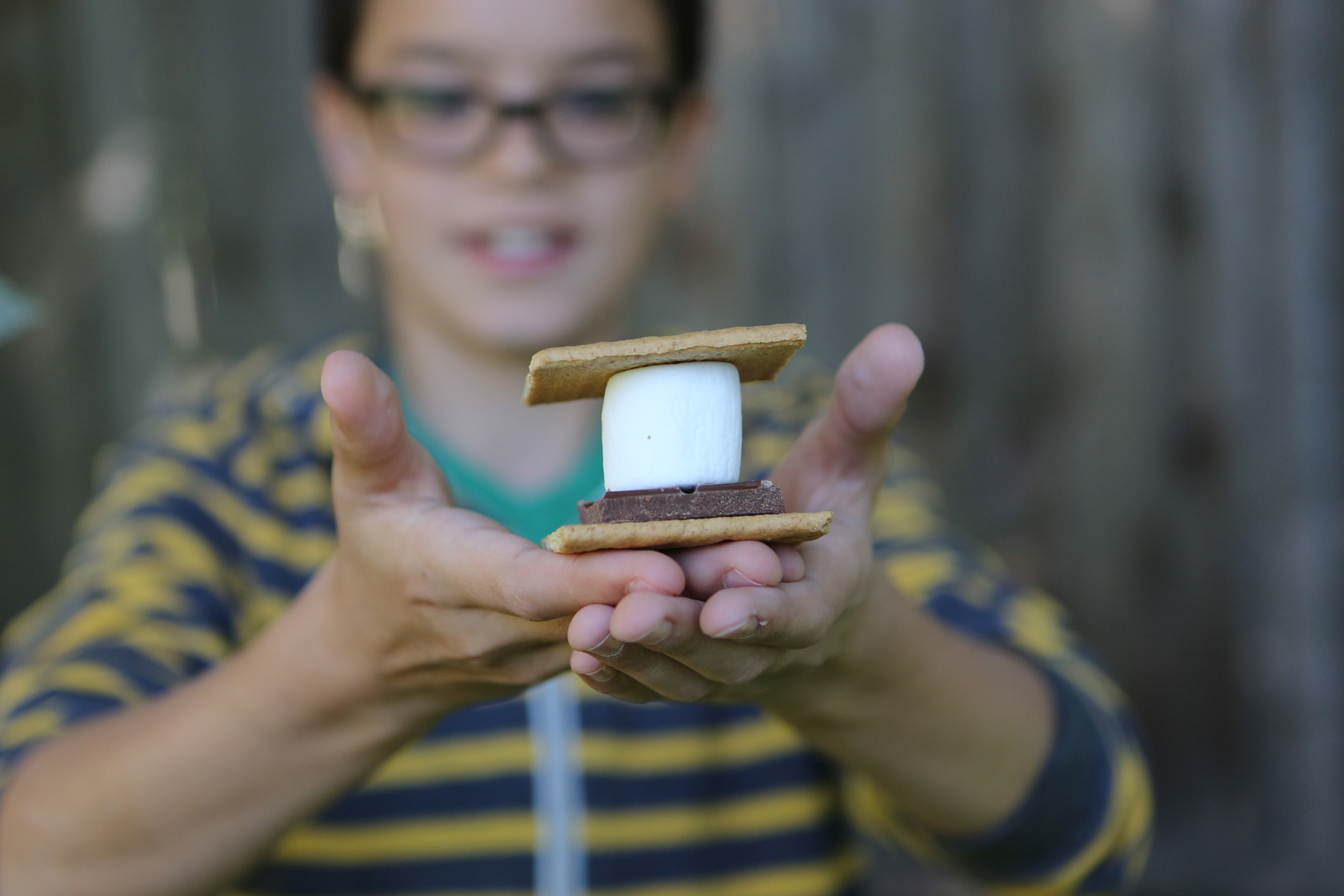
Solar Oven from Kitchen Science Lab for Kids (Quarry Books)
Homemade Transit of Venus Solar Viewer
- by KitchenPantryScientist
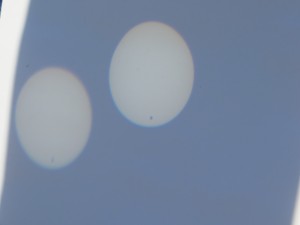
Our viewer is working really well! See Venus? We put a piece of paper behind the binoculars to get a bigger dark area on our viewer.
Although our pinhole viewers were great for watching the solar eclipse a few weeks ago, I was hoping to get a bigger projection of the sun’s image to watch the transit of Venus. (Venus is approximately the same size as earth and will be harder to see as it passes in front of the sun.)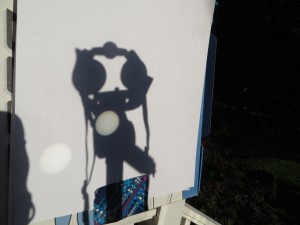
With a pair of binoculars and a tripod, you can project the sun’s image on a piece of white paper so that it’s large enough to see even some sunspots.
DO NOT LOOK AT THE SUN THROUGH THE BINOCULARS!!!
Simply attach them to your tripod so that the eyepieces are pointing away from the sun and the bigger ends are pointing toward the sun. We used duct tape. The sun should be behind the binoculars.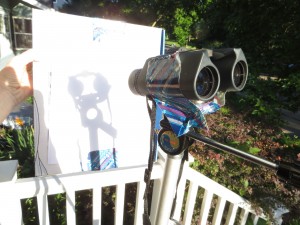
Hold up a piece of paper and adjust the angle of the binoculars on the tripod until you see double suns (there are 2 lenses) appear on your paper. If you can, adjust the angle further so that one of the images appears in the middle of the shadow of the binoculars. This will make it easier to see. You’ll notice that the further from the binoculars you hold the paper, the bigger the image will appear. It will get out of focus if you hold it too far away though.
We taped our white paper to a shoebox that we’ll be able to set on something when we watch the transit and won’t have to hold it the entire time!
Here’s a great article from today’s Science Times about the Transit of Venus.
Minnesota view of the Annular Eclipse
- by KitchenPantryScientist
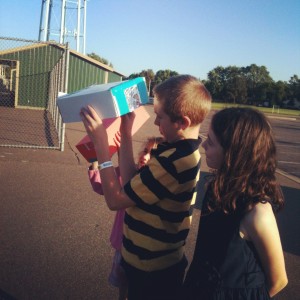 Our family trekked to the school parking lot to watch the Annular Eclipse last night. The kids ran and played, checking in every few minutes to peer through their solar viewers as the sun went from full circle to crescent-shaped. It was a blast!
Our family trekked to the school parking lot to watch the Annular Eclipse last night. The kids ran and played, checking in every few minutes to peer through their solar viewers as the sun went from full circle to crescent-shaped. It was a blast!
Here’s what we saw in our shoebox viewers before the sun disappeared behind the trees.
Some teenagers showed up at the parking lot with a telescope and projected the sun on a piece of cardboard. It was really cool, and the image was big enough that you could see a sunspot!
Hold on to your shoe box viewers! On June 5th, Venus will pass between Earth and the sun. I’ll find out more about it and let you know how to watch it!
Solar Storms and the Zombie Apocalypse
- by KitchenPantryScientist
My son came home from school the other day joking about a zombie apocalypse. Before that, it was the Mayan apocalypse. And now, he keeps hearing about all these “freaky” solar storms. He laughs, but I’m sure his 11-year-old imagination leaves plenty of room for worry.
I can’t kill the zombies lurking in his subconscience, but I can put his mind (and my own) at ease about the solar storms with this short NASA video that explains that we’re in a totally normal sun cycle and are protected by Earth’s atmosphere
Solar Water Purification
- by KitchenPantryScientist
How would you get water to drink if you were stranded on a desert island, surrounded by salty ocean? If you happened to have a big leaf and a few concave (bowl-like) items- maybe a big shell and a smaller shell, you could make a solar water purifier to collect drinking water.
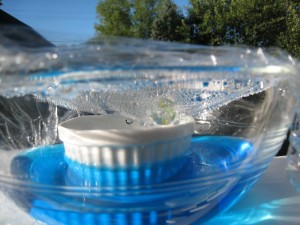
Even if you’re not on a desert island, it’s fun to make your own solar water-purifier using a big big bowl, a small bowl, some plastic wrap and a marble or a pebble. You’ll also need salt and food coloring to “contaminate” the water you’ll be purifying. This experiment works best on a hot, sunny day since it harnesses the power of the sun’s rays to clean the water.
Put the small bowl inside the big bowl. The top of the small bowl must be lower than the top of the big bowl.
In a separate container, mix together water, salt and food coloring until you have a mixture too salty to drink. Pour the water into the big bowl, making sure the liquid stays outside of your small bowl, since you’ll be collecting clean water in the small bowl.
Loosely cover the top of the bowl with a single piece of plastic wrap. Place a pebble or marble in the center of the plastic wrap and adjust the wrap so that there is a dip directly above the small collection bowl. Try to seal the plastic wrap around the edges of the bowl as well as you can.
Now, place the bowl in the sunlight. The sun’s ultraviolet rays will go through the plastic wrap and into the colored water, where they’ll be absorbed and re-released as heat energy. Since the heat can’t escape back out through the plastic wrap, the air and water in the bowl heat up.
The warm temperature helps water molecules on the surface evaporate, or escape, into the air in the bowl. When they collide with the plastic wrap, they encounter a cooler surface since the air outside the bowl is not as warm. This causes them to condense, or form droplets, on the plastic wrap. When the droplets get big enough, gravity pulls them to the lowest part of the plastic wrap (the dip) and they drip into the collection container.
When you’ve collected enough purified water (be patient- it can take a day or two), you can taste the water to see how your purifier worked. Be sure to wipe of the bottom of the collection bowl before you pour it out so you don’t contaminate your clean water!
A variation on the experiment is to add vinegar to the water, purify it, and check the pH of your starting and purified water using litmus paper. You can make your own litmus paper using red cabbage!
